
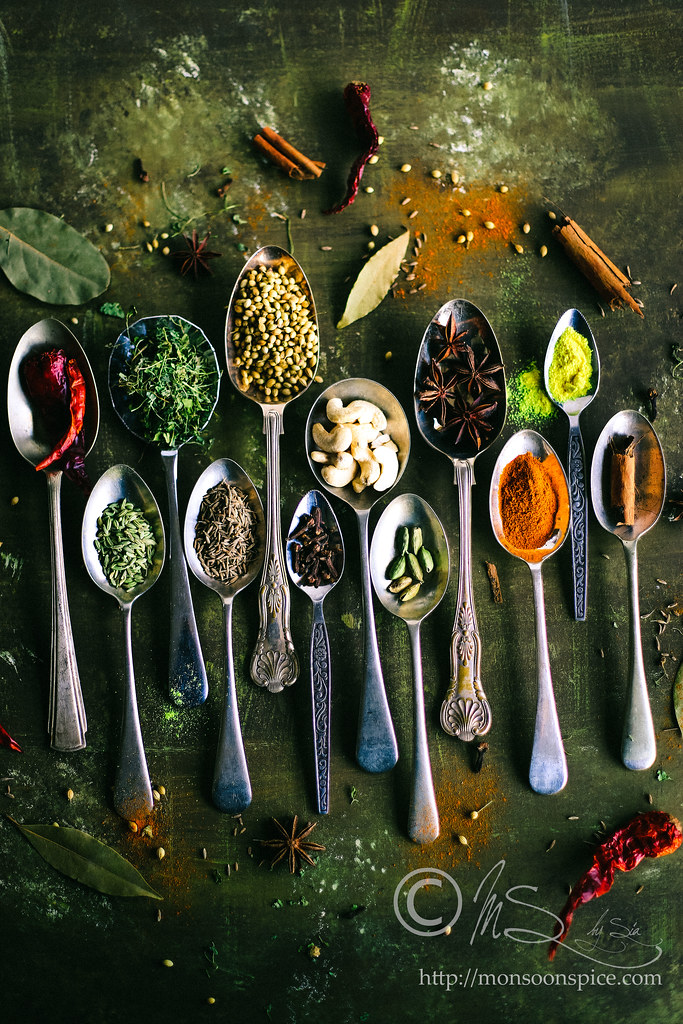


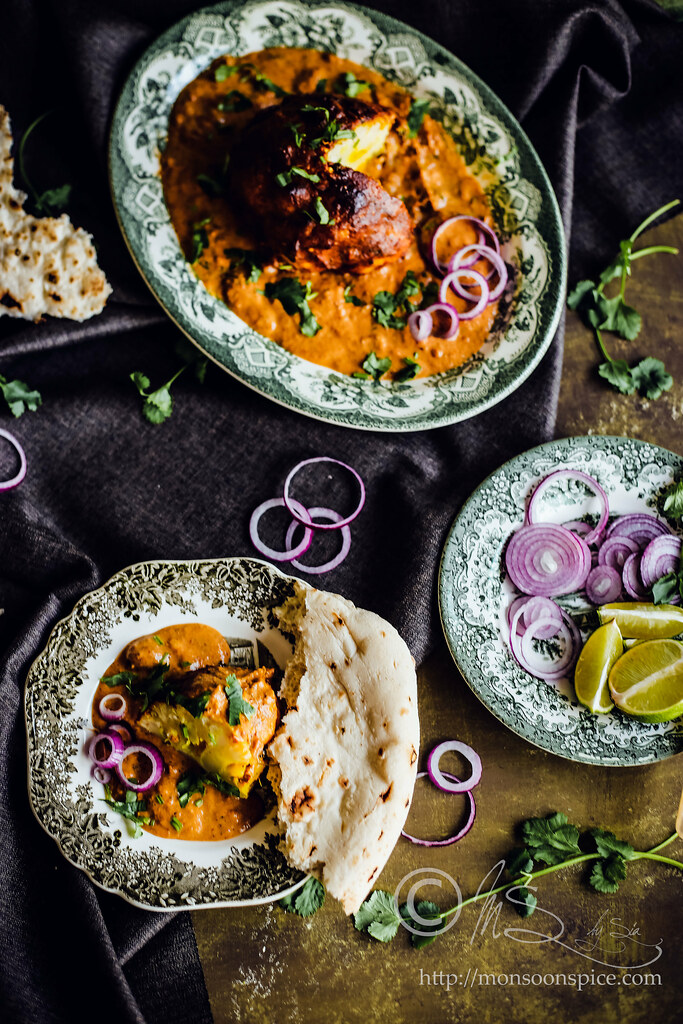
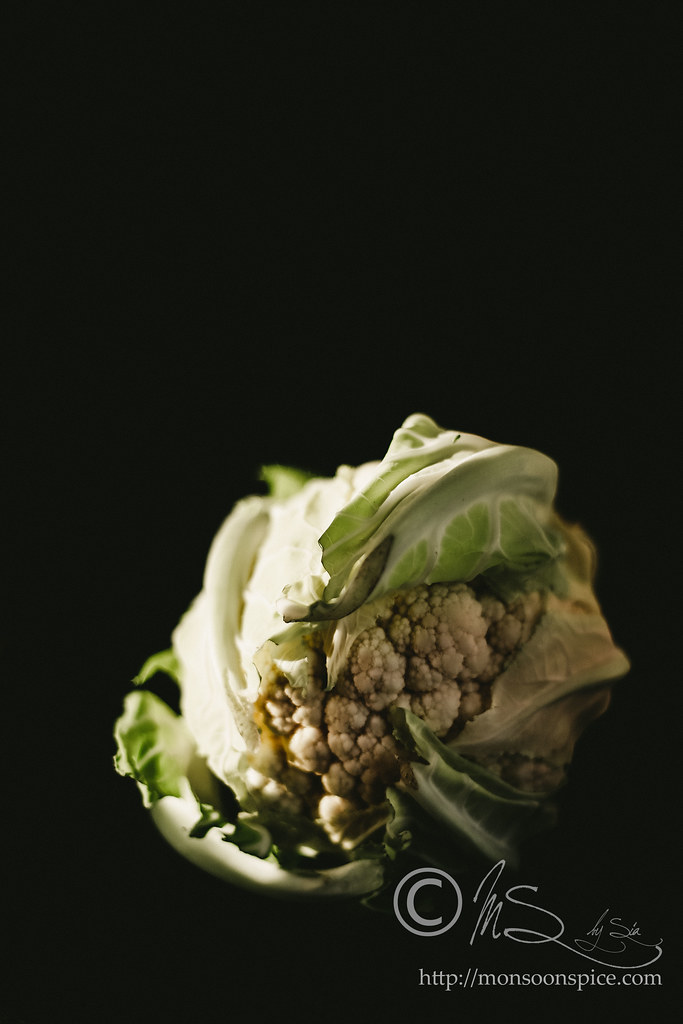


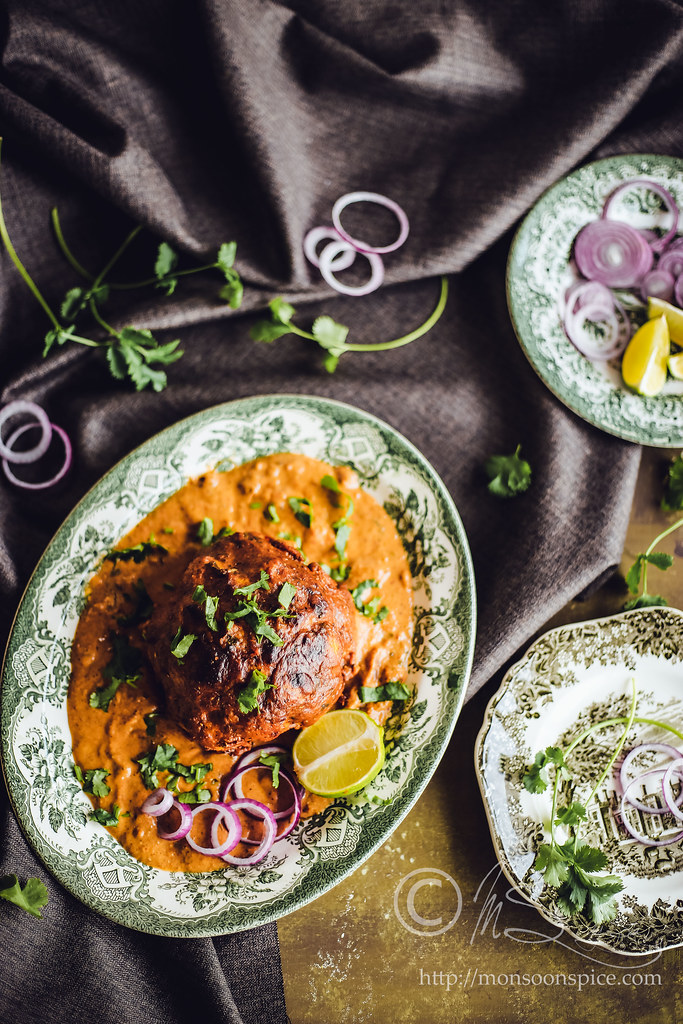
Vegan Gobi Musallam (Whole roasted cauliflower cooked in mildly spiced creamy cashew and coconut gravy)
Prep Time: 15 mins
Cooking Time: 45 mins
Recipe Level: Easy/Beginner to Intermediate
Spice Level: Low to Medium
Serves: 5-6 people
Shelf Life: Best served fresh, but can be refrigerated for 2-3 days
Serving Suggestion: With any Indian flat breads (Whole Wheat Naan or Butter Naan or with any stuffed parathas) or plain/flavoured Basmati rice
Ingredients:
1 small Cauliflower (about a size of palm)
½ tsp Haldi/Turmeric Powder
1 tsp Salt
For Makhani Gravy:
1 large or 1 cup Onion, peeled and roughly chopped
3 medium Tomatoes, roughly chopped
3-4 large cloves of Garlic, peeled and sliced
1 inch Ginger, peeled and chopped
1 cup thick Coconut Milk (fresh or from a tin/can)
10 – 12 whole Cashew Nuts
1 tsp Sugar
Salt to taste
1 tbsp Oil
Spices Used for Makhani Gravy:
1 inch Cinnamon Stick
1-2 Bay Leaves
5-6 Green Cardamoms
4-5 Cloves
1 small Star Anise
1 tsp Jeera/Cumin Seeds
1 tsp Saunf/Fennel Seeds
1 tbsp Dhania/Coriander Seeds
3-4 Dry Red Chillies (I used a combination of Kashmiri Chillies and the spicy ones)
1 tbsp Kasuri Methi/Dry Fenugreek Leaves
½ tsp Haldi/Turmeric Powder
¼ tsp Hing/Asafoetida (Optional, but recommended)
For Garnishing:
1-2 tbsp Coriander Leaves, finely chopped
1 small Onion, peeled and sliced into rings


Method:
Preparation:
- Remove the leaves and stem from cauliflower and wash it thoroughly.
- Chop the vegetables for the gravy (onions, tomatoes, garlic and ginger) and keep them aside.
- Soak the cashew nuts in hot water for 5-10 mins.
- If using fresh coconut milk, prepare the coconut milk and keep it aside.
Proceed to cook:
- Take a pan, large enough to hold the head of cauliflower, and add enough water to immerse the entire cauliflower. Add turmeric powder and salt to taste and bring it to boil. Once the water comes to a boil, place the cauliflower in the water and cover and cook for 3-4 mins. Remove the lid and flip the cauliflower and turn off the flame. Let it sit in hot water for 4-5 mins. Drain all the water and keep the partially cooked cauliflower in the side until needed.
- While the cauliflower is cooking, prepare the makhani gravy by heating ½ tbsp. oil in a pan on medium flame. Once hot, add cinnamon stick, cloves, green cardamoms, bay leaves and the star anise. Let them sizzle in a hot oil for about 30 seconds.
- Next add cumin seeds, fennel seeds, coriander seeds and dry red chillies and fry them by stirring continuously for 40-60 seconds until the spices change colour to deeper shades of brown. Do take care not to burn the spices as burnt spices will make the gravy taste bitter.
- Transfer the roasted spices to mixer grinder/food processor. In the same pan, heat the remaining ½ tbsp. oil on medium flame and once hot, add finely chopped garlic. Fry the garlic for about 2 minutes until the edges turn golden brown.
- Add roughly chopped onions and ginger along with a tsp of sugar and a generous pinch of salt. The sugar helps in caramelising the onions and the salt helps to cook the onions quickly. Sauté the onions for 2-3 minutes until they turn golden brown.
- Next add chopped tomatoes, turmeric powder and half of kasuri methi/dried fenugreek leaves and cook them until the tomatoes soften and release their juice, about 3 mins.
- Drain all the water from the soaked cashew nuts and add the cashew nuts to the pan and mix well. Turn off the heat and let the mixture cook down to room temperature.
- Transfer the onion and tomato mixture to the mixer grinder/food processor and grind them to smooth paste along with the roasted spices without adding any water.
- Transfer the ground spice and onion mixture back into the pan and fry them for 2-3 minutes on medium flame. Add remaining kasuri methi and mix them well.
- Next add the coconut milk and salt to taste and bring the gravy to gentle boil. The gravy should be fairly thick enough to coat the cauliflower and hold well without running down. Taste the gravy and adjust the seasonings before turning off the heat.
Proceed to bake/roast the cauliflower:
- Pre-heat the oven at 400 deg F or 200 deg C.
- Take baking tray or oven proof dish and place the blanched whole cauliflower upside down. Pour a spoonful of gravy and spread it well to coat the cauliflower well. Gently flip it over and pour the gravy to coat the entire cauliflower. Do not worry if some sauce drips and falls on the side.
- I needed about half of prepared makhani gravy to coat the entire head of cauliflower. Keep aside the remaining makhani gravy aside to serve on side later.
- Bake the cauliflower for 25-45 mins (depending on the size of a cauliflower) till the cauliflower is nicely roasted and is dry to touch. Make sure to turn the dish around half way through baking to make sure that cauliflower is cooked well.
- To roast the cauliflower on stovetop, place the cauliflower upside down in a heavy bottomed pan and close it with a lid. Dum cook this cauliflower on medium to low flame without disturbing for about 8-10 minutes until its roasted and brown spots appear on the surface. Carefully flip the cauliflower and close the lid and cook again undisturbed for 8-10 minutes until the whole cauliflower is cooked through. The cauliflower will get roasted and turn little crisp with brown spots on. Please note that the cooking time will vary depending on the size of cauliflower used.
- While the cauliflower is getting roasted, add about ½ cup of water (or more to get desired consistency) to the remaining gravy and bring it to gentle boil.
- Transfer this gravy into a serving dish before placing the roasted cauliflower. Garnish it with finely chopped coriander leaves and onion rings. You can also sprinkle some flakes of almonds if desired.
- Serve this delicious Gobi Musallam with any roti, naan, paratha or with flavoured basmati rice. The sliced cauliflower of this Vegan Gobi Musallam also makes a wonderful and satisfying filling for pitta bread or warps with some sliced onions, tomatoes and salad leaves. Enjoy!

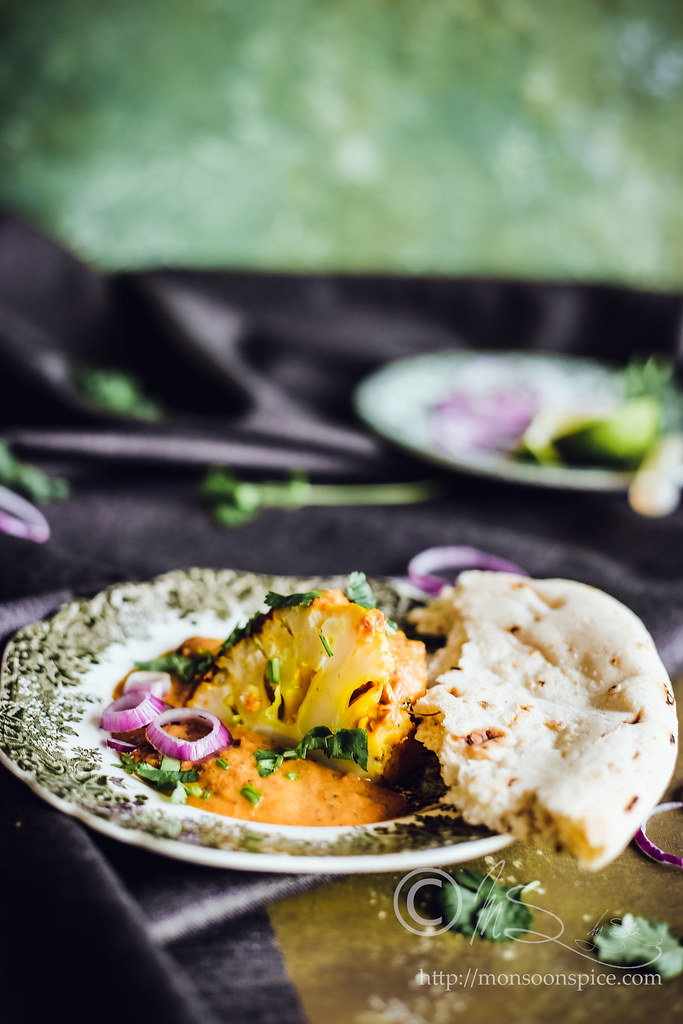
Sia’s Notes:
- Whenever I make rich makhani/buttery gravy, I prefer to use whole spices instead of ready to use grounded spice powders.
- I have used coconut milk to give creamy base to the gravy along with cashew nuts. You can replace the coconut milk with fresh cream if you are not too fond of the taste of coconut.
- If you are allergic to nuts, simply skip the cashew nuts or replace it with 1 tbsp of melon seeds. Soak the melon seeds in hot water for 10-15 minutes and grind them with other ingredients as mentioned in the recipe.
- Please note that the cooking time will vary depending on the size of cauliflower used. I have used a small cauliflower, roughly a size of my small palm.
- You can serve this delicious Vegan Gobi Musallam with any roti, naan, paratha or with flavoured basmati rice. The sliced cauliflower of this Gobi Musallam also makes a wonderful and satisfying filling for pitta bread or warps with some sliced onions, tomatoes and salad leaves.

I love roasted cauliflower so much and this dish looks incredible! So colorful!
ReplyDeleteThanks, Kristine! Indian food is all about spices, flavours and also colours 😀
DeleteI love dishes that use lots of different spices, so comforting this time of year. This looks like a winner!
ReplyDeleteThank you 😊 And you just described the mood of this season so well. Spices make everything taste better and brings that warm, comfort feeling.
DeleteJust fell in love with your version of using coconut milk, I will try it out next time. Photos are just fabulous. Just love it
ReplyDeleteThanks, Jayashree 😊🙏🏼 Coconut milk gives that sublime sweet hint and creaminess to the gravy. I love replacing fresh cream with coconut milk in most of the recipes.
DeleteLoving everything about this! The small head of cauliflower - so cute! All the amazing spices - can only imagine how aromatic and flavorful this is
ReplyDeleteThank you, Regina 🙏🏼😊 The aroma of roasted cauliflower with spices is just heavenly.
DeleteGlorious pictures Sia!! It's definitely a fascinating recipe - my grandmother used to cook a whole head of cabbage - this cauliflower reminds me of that! I can't wait to try this - I am a sucker for cauliflower!
ReplyDeleteThank you, Tina 😊🙏🏼 Me too. I just can't get enough of cauliflower. Cauliflower is such an underrated veggie but I love the fact how versatile it is when it comes to cooking.
DeleteThat looks mouthwatering! I'm a big fan of cauliflower and curries, so I find this dish is extremely appealing.
ReplyDeleteCheers,
Rosa
www.reveriesbramblesscribbles.com/blog/
Thanks, Rosa 😀🙏🏼 I too am a huge fan of this veggie. When cooked right, it can beat my most fav spuds to shame 😀
DeleteSia, I love reading your blog posts and recipes the photos make my mouth water :) you post are so vibrant yet soothing. Am definitely going to try this recipe this holiday season because my daughter is home from the university for her holidays.
ReplyDeleteThank you! 🙏🏼 You are too generous with compliments. Glad you liked the post and the recipe. It sure is a winning dish and surprisingly, is quite easy to make as well. Please do leave a feedback when you try this out 😀
DeleteAnother beautiful dish from you Sia. Absolutely love gravies with coconut milk, will try this for the upcoming holiday get together am having.
ReplyDeleteThanks a lot, Shilpa! Would love to hear your feedback when you try this recipe. :)
DeleteHi Sia
ReplyDeleteThe recipe looks wonderful, want to try out, I just have a doubt, how do we deworm the gobhi. When we cut the gobhi lot of small worms come out at times, will boiling it in water full the way you have done will be enough. Will try out, thanks for the recipe.
Love Manisha
Hi Manisha, my mother always boils soaks the cauliflower in a warm water filled bowl with a tsp each of turmeric n salt for at least an hour and it helps to get rid of any worms n pesticides. Also boiling it in water with haldi n salt also gets rid of them. Hope this helps 😀
DeleteSo colourful and beautiful, it is on my to do list for this weekend since this is a great recipe to enjoy with my family, thanks for sharing!
ReplyDeletePrachi Gupta
Personalised Chocolate
I can’t wait to make this! Perfect for a typical Pacific Northwest rainy afternoon. Photos are stunning, as always :)
ReplyDeleteAshi Verma
Dark Chocolate
I can’t wait to make this! Perfect for a typical Pacific Northwest rainy afternoon. Photos are stunning, as always :)
ReplyDeleteAshi Verma
Dark Chocolate
I made this tonight. What a wonderful, flavourful recipe!! My partner and I have agreed that this may become part of our 'regular' meals. We loved it. Thank you!
ReplyDelete